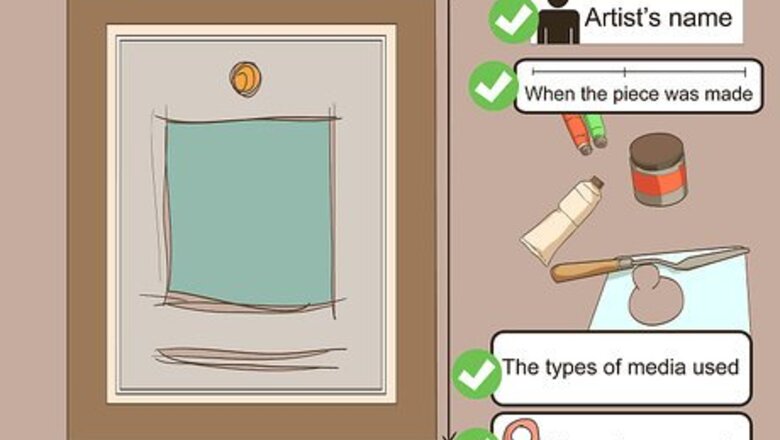
views
Describing the Work

Gather basic information about the work. This is the sort of thing you’d find on a museum or gallery label, or in the caption in an art book. Knowing the background of a piece can make a big difference in how you interpret and understand it. Start your critique by providing the following information: Title of the work Artist’s name When the piece was created Where it was made The types of media used to create the work (e.g., oil paint on canvas) The exact size of the work
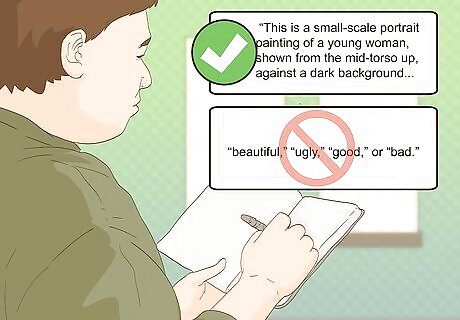
Describe what you see. Using neutral terms, describe the artwork. Your description should include things like the form and scale of the work. If the art depicts figures or objects rather than abstract shapes, describe what is represented. For example, you might say, “This is a small-scale portrait painting of a young woman, shown from the mid-torso up, against a dark background. She is clasping her hands in front of her chest and looking up and slightly to the viewer’s right. She wears a pink dress, and a long veil that falls behind her head.” Avoid using terms like “beautiful,” “ugly,” “good,” or “bad.” At this point, you’re just talking about what you see, not judging the art!
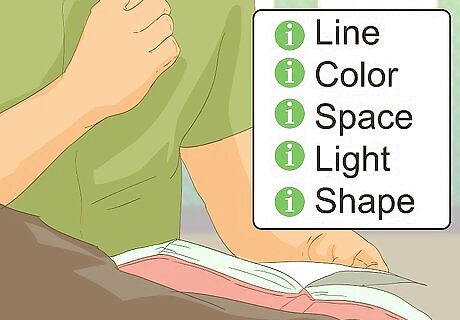
Discuss the elements of the work. Now describe the work in more detail. Talk about the way the art uses these five basic elements of art and design: line, color, space, light, and shape.

Describe the use of line. Lines in a work of art can be either literal or implied. Different types of lines can create different moods or effects. For example: Curved lines can create a calming effect, while jagged lines might feel harsher and wild, or create a sense of energy. Rough, sketchy lines create a sense of movement and freedom, while smooth, solid lines feel more still and carefully planned. A line of sight or action might be suggested by the arrangement of figures and objects within a scene. For example, a group of figures all looking or pointing the same way can create an implied line that draws your eye through the work in a particular direction.
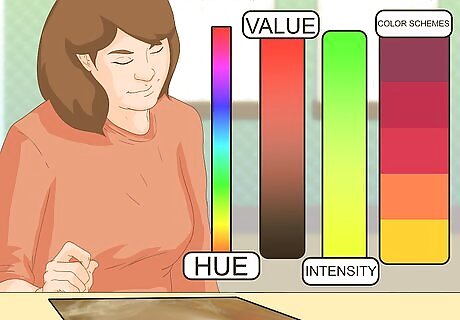
Talk about how color is used in the work. Make note of characteristics like hue (red, green, blue, etc.), value (lightness or darkness), and intensity. Look at overall color schemes, and think about how the colors work together. For example, do the colors clash, or are they harmonious? Does the work use a variety of colors, or is it monochromatic (all shades of blue, for example)?
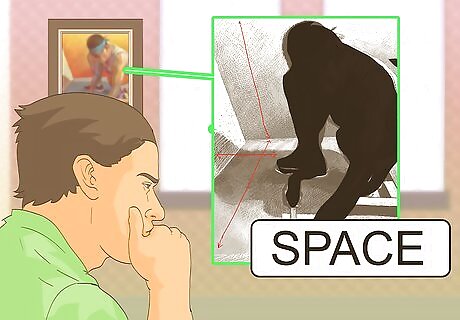
Describe the use of space in the work. “Space” refers to the areas around and between objects in a work. When talking about space, focus on things like depth and perspective, overlapping of objects, and the use of empty space versus space crowded with details. If you are describing a two-dimensional work of art, like a painting, talk about whether or not the work creates the illusion of three-dimensional space and depth.
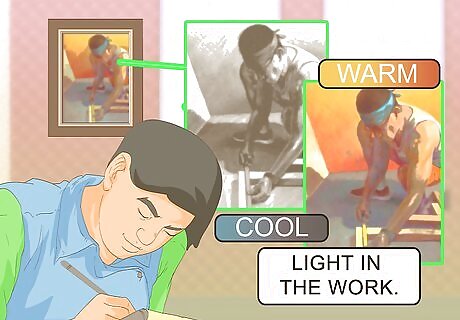
Describe the use of light in the work. Light in a work of art can look warm or cool, bright or dim, natural or artificial. Take a little time to talk about the role of light and shadow in the work. If you’re talking about a two-dimensional work, like a painting, your focus might be on how the artist creates the illusion of light. For a three-dimensional work, like a sculpture, you could discuss how actual light interacts with the work. For example, is the surface reflective? Does the sculpture cast interesting shadows? Are some parts of the sculpture more shadowed or well-lit than others?
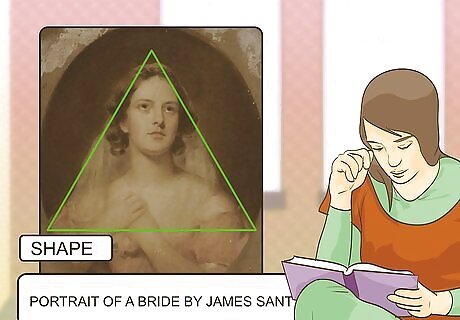
Make note of the way shape is used in the work. Are the shapes in the work geometric, with straight lines and perfect curves, or are they more natural? Is the work dominated by any one particular type of shape, or do you see a variety of different shapes? Shapes play an important role in both abstract and representative works. For instance, in a portrait of a bride by James Sant, there are notable triangle shapes made by the drape of the bride’s veil around her shoulders and the clasped hands in front of her chest. Once you notice one shape in a painting, look to see if it is repeated anywhere else.
Analyzing the Work

Discuss how the work uses the principles of composition. Once you have described the work, it’s time to analyze it, or discuss how it all comes together. Start by talking about how the work is composed, keeping a few basic ideas in mind. For example: Balance: How do the colors, shapes, and textures in the piece work together? Do they create a balanced or harmonious effect, or is the piece imbalanced in some way? Contrast: Does the work make use of contrasting colors, textures, or lighting? Contrast can also be found in the use of different shapes or contours, like jagged versus curved lines, or geometric versus natural shapes. Movement: How does the work create a sense of movement? Is your eye drawn through the composition in a particular way? Proportion: Do the sizes of the different elements in the work appear the way you would expect, or are they surprising? For example, if the work shows a group of people, do any of the figures look larger or smaller than they would in real life?
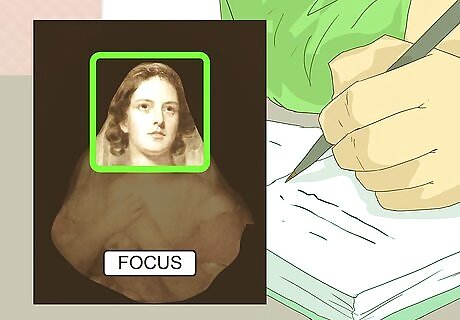
Identify the point(s) of focus of the work. Most works of art have one or more points that are designed to catch your attention and draw your eye. In a portrait, this may be the face or eyes of the subject. In a still-life, it could be a centrally-placed or well-lit object. Try to identify which parts of the work are emphasized. Look at the work and make note of which feature(s) jump out at you right away, or keep drawing your eye back to them. Ask yourself why your eye is attracted to the feature(s) in question. For example, if you find yourself fixating on one figure in a group, is it because that figure is larger than the others? Are they closer to the viewer? More brightly lit?
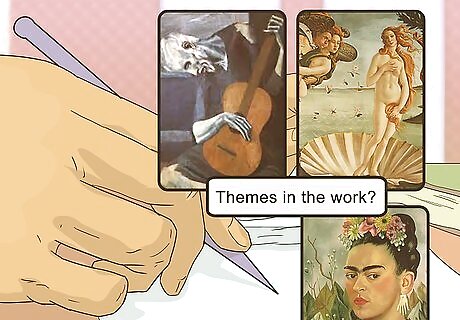
Look for themes in the work. Identify a few key themes, and discuss how the artist used the elements of design (color, light, space, shape, and line) to express these themes. Themes might include things like: The use of a color scheme to give the work a particular mood or meaning. See, for example, the paintings of Picasso’s Blue Period. Symbolism and religious or mythological imagery. For example, look at the use of figures and symbols from classical mythology in Renaissance works like Botticelli’s “Birth of Venus.” Repeating images or motifs within a work or group of works. For a good example of this, look at how plants and flowers are used in many of the paintings of Frida Kahlo.
Interpreting the Work

Try to identify the purpose of the work. In other words, what do you think the artist was trying to say with the work? Why did they create the work? Try to summarize the overall meaning of the work, as you see it.

Describe your own reaction to the work. Now it’s time to get a little more subjective. Think about how you feel while looking at the work. What do you think is the overall mood of the work? Does it remind you of anything (ideas, experiences, other works of art)? Use expressive language to talk about your reaction to the work. For example, is the mood of the work sad? Hopeful? Peaceful? Would you describe the work as beautiful, or ugly?
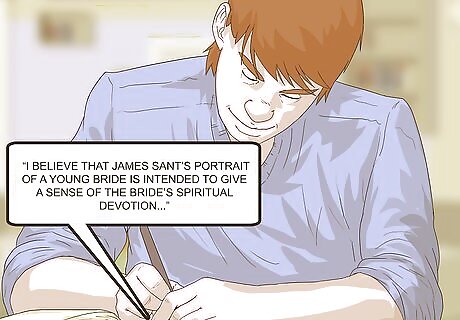
Back up your interpretation with examples. Use examples from your description and analysis of the work to explain why you think and feel the way you do about the piece. For example, “I believe that James Sant’s portrait of a young bride is intended to give a sense of the bride’s spiritual devotion. This is indicated by the line of the composition, which draws the viewer’s eye upward, following the upward gaze of the subject. It is also suggested by warm light, coming from a source somewhere above the young woman.”
Judging the Work

Decide whether you think the work is successful or not. Your goal here isn’t necessarily to decide whether the art is “good” or “bad.” Instead, focus on whether you think the work is “successful.” For example, think about the following: Do you think the work says what the artist wanted it to say? Did the artist use their tools and techniques well? Is the art original, or does it imitate other works?

Explain how you are judging the work. Once you have decided on a few aspects of the work to judge, clearly state the focus of your evaluation. For example, you might say that you are judging the piece on how well organized it is, how well done it is technically, and how successfully it portrays the intended mood or themes.

Summarize why you think the work is successful or unsuccessful. In a few sentences, explain your judgment of the work. Give specific reasons for your judgment, using your interpretation and analysis of the work. For example, “I believe this work is successful because the use of light, shape, gesture, and line all work together harmoniously to portray the mood of the subject.”



















Comments
0 comment